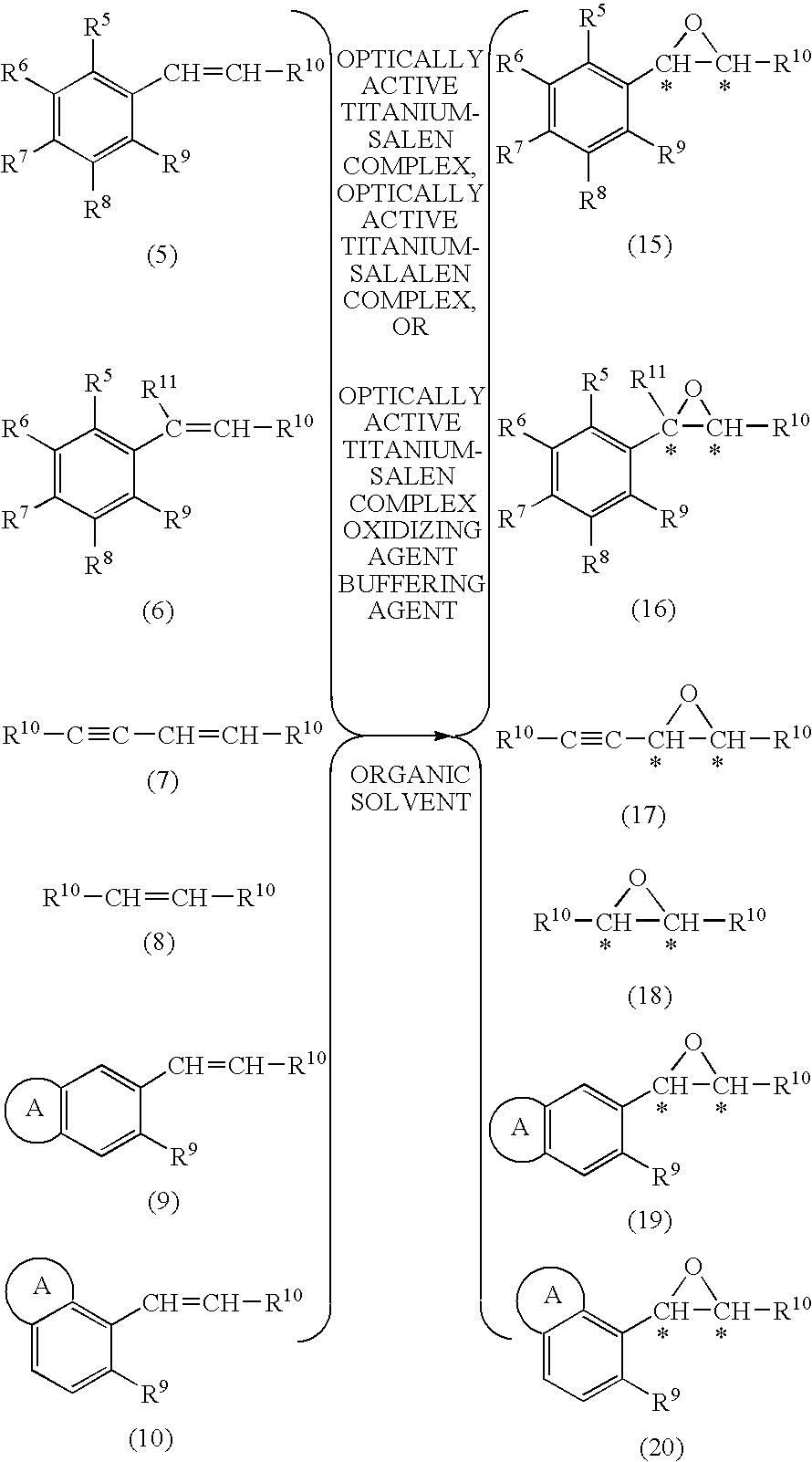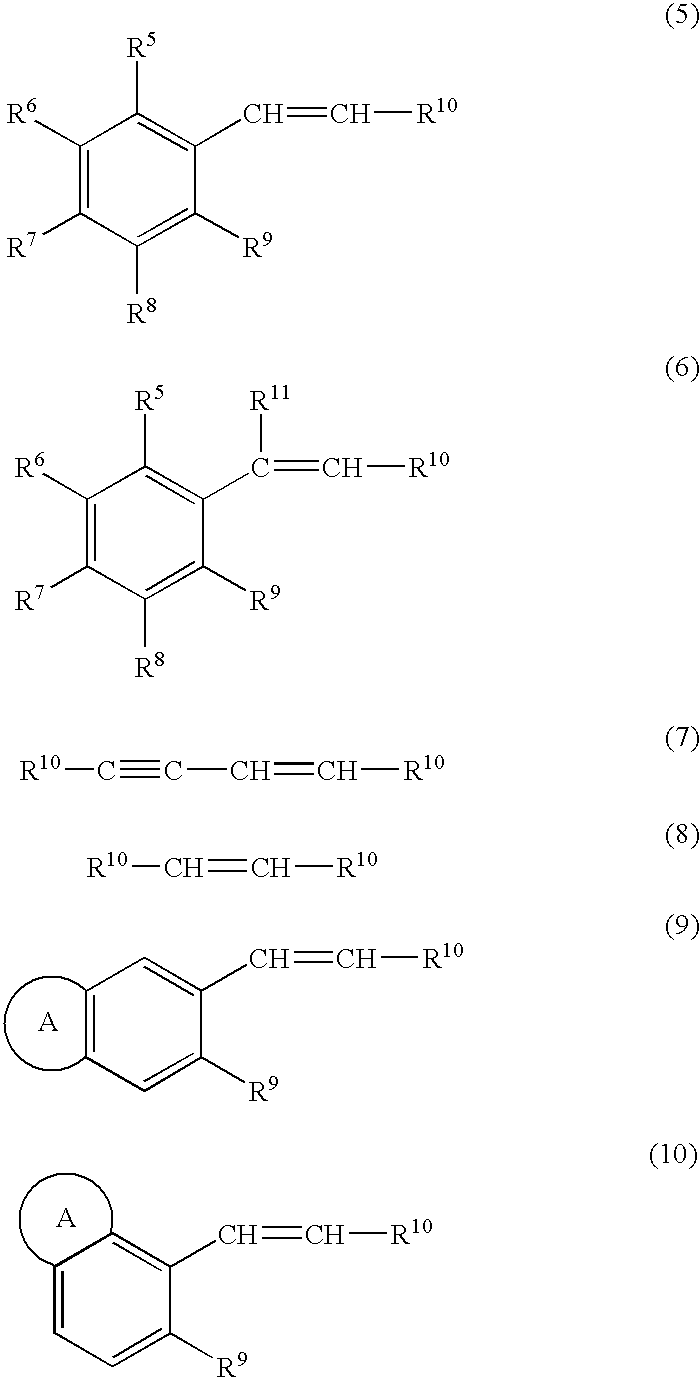Process for production of optically active epoxy compound
a technology of epoxy compound and optically active compound, which is applied in the direction of organic compound/hydride/coordination complex catalyst, organic chemistry, physical/chemical process catalyst, etc., can solve the problems of complex insufficient applications, high molecular weight of titanium complex used in the art, and high cost and time consumption of synthesis of titanium-salalen complex, etc., to achieve high chemical yield and optical yield, reduce the amount of used catalyst, and improve the efficiency of catalyst to be used
- Summary
- Abstract
- Description
- Claims
- Application Information
AI Technical Summary
Benefits of technology
Problems solved by technology
Method used
Image
Examples
example 1
[0110]The optically active titanium-salan complex (3.1 mg, 0.0026 mmol, a catalytic amount of 1 mol %) (synthesized according to the method described in Patent Document 1: International Publication WO 06 / 087874, pamphlet) represented by Formula (I):
(S in Formula (I) means the absolute configuration (S)) and indene (30 mg, 0.26 mmol) were dissolved in dichloromethane (1.2 mL). A phosphate buffer solution adjusted to pH 7 (50 mM, 90 mg, 0.0045 mmol (calculated on the basis of phosphoric acid)) was added to the reaction solution, subsequently 30% aqueous hydrogen peroxide (44 mg, 0.39 mmol) was added, and the mixture was stirred at 40° C. to react. The conversion rate of the reaction (%), the relative area percentage of by-products (%) and the optical purity (% ee) were analyzed by HPLC (analysis conditions: Daicel CHIRALCEL OJ, hexane / isopropanol (8 / 2=v / v), a flow rate of 0.8 mL / min, a wavelength of 210 nm, 35° C.) after 2 hours and 4 hours, respectively. The conversion rate from inde...
example 2
Example 2A, Example 2B and Example 2C
[0112]To a dichloromethane solution (11.6 mL) dissolving the optically active salan ligand (92.6 mg, 0.17 mmol, a catalytic amount of 1 mol %) represented by Formula (II):
(S in Formula (II) means the absolute configuration (S)), a dichloromethane solution dissolving Ti(Oi-Pr)4 (48.9 mg, 0.17 mmol, a catalytic amount of 1 mol %) was added and the mixture was stirred at 25° C. for 1 hour. Then, without isolation of the optically active titanium-salan complex, dichloromethane (37.7 mL), indene (2.0 g, 17.2 mmol) and a phosphate buffer solution (the mass was 3 times with respect to that of indene, the concentration and pH are shown in the following Table) were continuously added to the reaction solution. Subsequently, commercially available 30% aqueous hydrogen peroxide (2.9 g, 25.8 mmol) was added and the mixture was stirred at a reaction temperature of 40° C. to react. The reacted solution was sampled to check the conversion rate. At the end of the...
example 3
[0114]The reaction was carried out in the same experimental procedure as in Example 2 with the addition of 25 mM phosphate buffer solution adjusted to pH 11. The conversion rate of the reaction (%) and the relative area percentage of by-products (%) were analyzed by HPLC after 1 hour, 3 hours and 4 hours. The results along with the quantitative yield and the optical purity are shown in the following Table 5.
TABLE 5(Example 3)HPLC relative areapercentage, 210 nmRetention time6.2 to 7.8 minRetention timeReactionConversionTotal relative10.8 minOpticaltimerateareas ofRelative area ofQuantitativepurity(h)(%)by-products (%)by-product (%)yield (%)(% ee)1 h69%5%Not detected9998.33 h95%11%Not detected4 h98%9%Not detected
PUM
| Property | Measurement | Unit |
|---|---|---|
| Optical properties | aaaaa | aaaaa |
| Optical activity | aaaaa | aaaaa |
Abstract
Description
Claims
Application Information
 Login to View More
Login to View More - R&D
- Intellectual Property
- Life Sciences
- Materials
- Tech Scout
- Unparalleled Data Quality
- Higher Quality Content
- 60% Fewer Hallucinations
Browse by: Latest US Patents, China's latest patents, Technical Efficacy Thesaurus, Application Domain, Technology Topic, Popular Technical Reports.
© 2025 PatSnap. All rights reserved.Legal|Privacy policy|Modern Slavery Act Transparency Statement|Sitemap|About US| Contact US: help@patsnap.com



